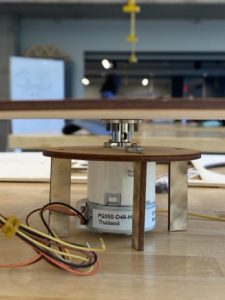We anticipate lots of iterations to our initial design as we move on to the implementation phase. The vertical and radial aiming system might encounter issues with lack of torque that prevents the mechanical parts, which will force us to use a different design that uses gears to increase the torque output (or order another motor with a greater torque). The pressure system poses a mechanical challenge of reliably holding the pressure without leaks. The frontend design could be unintuitive to the new user once we start user testing. All of these risks could throw us off schedule. We plan on tackling these challenges by staying ahead of schedule and designing contingency designs with different tradeoffs in case the first design doesn’t work as intended.
There were two major changes to the design this week: The vertical aiming system will no longer use a linear actuator, but use a servo motor. We made this decision based on the feedback from the meeting with the professor, as it eliminates lots of noise and complexity when a triangulation-based design is used – the cost of the motor is a lot cheaper as well. The CV portion was changed to use a more low granularity LIDAR camera as the other group that planned on using that camera has returned the equipment. Both of these changes improve our designs’ robustness, and reduce the cost.
There are no schedule changes as we’re still ahead of schedule. We are working hard on individual subsystems while preparing for our design presentation next week.
Part A was written by Alex:
PongPal plays a crucial role in addressing public health concerns, specifically in preventing the spread of viruses like coronavirus. By allowing players to engage in water pong remotely through a web-based interface, PongPal minimizes physical contact and the need for individuals to be in close proximity during gameplay. This adheres to health and safety guidelines from the CDC while also reducing the risk of virus transmission. Moreover, the remote play option opens up new possibilities for individuals with disabilities who may face challenges in participating in physical activities. PongPal is an inclusive platform, promoting mental health and well-being by providing an enjoyable and accessible gaming experience for a broader range of users.
Part B was written by Mike:
PongPal was designed with social interaction in mind. Many social groups form around a shared love for water pong, therefore allowing the game to be more inclusive can help those who could not normally play the game socially interact with water pong enthusiasts. PongPal’s remote aspect can also allow for competition thousands of miles away, allowing for an increased web of social interaction, thus growing the water pong enthusiast community. By considering social, cultural, and political dimensions, PongPal enhances the overall social experience, fostering a sense of camaraderie among players and contributing positively to the social fabric surrounding the game.
Part C was written by Simon:
PongPal’s economic factors are addressed through its accessibility and affordability. The product utilizes existing technology, making it cost-effective and reducing the economic barrier to entry. The system of production and distribution can be streamlined if mass produced, ensuring efficient availability of the robot and its accompanying web platform.






